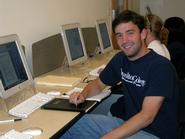
Greg Hartt '08, Tim Evans '05, co-director of the Center for Molecular Design Karl Kirschner and Winslow Professor of Chemistry George Shields published an article titled "In Search of CS2(H2O)n=1-4 Clusters" in the April 21 issue of Journal of Chemical Physics. The research has potential impact for understanding the uncertainties in global warming.
Currently, the biggest uncertainty in how hot the Earth will heat up from global warming has to do with the role of clouds, and how much overall cloud cover contributes to global cooling. As the temperature on Earth increases, more water vapor enters the atmosphere, and interactions with sulfur molecules and water are a leading cause for the formation of aerosol particles. Clouds are composed of aerosol particles, and certain types of clouds have a negative feedback effect, resulting in cooling of the Earth. Models that predict the increase in the Earth's temperature from the Greenhouse Effect have the most uncertainty in this negative feedback cycle. Understanding how aerosols and clouds form from water and sulfur molecules in a warming Earth is essential basic knowledge that will enhance our understanding of the expected magnitude of global warming.
 |
|
Tim Evans '05 |
Hartt had to overcome major technical difficulties in modelling the intermolecular interactions between carbon disulfide and water, discovering that a more rigorous method based on second order perturbation theory was absolutely essential for modelling these clusters than was previously thought. The researchers predict that very few CS2(H2O)n clusters are present in the atmosphere, and reveal where in the infrared spectrum experimentalists can detect these structures using laser spectroscopy in the laboratory.
Hartt wrote the first draft of the paper starting from Evans' thesis. Evans is in graduate school at New York University, and has published two papers from his senior research projects. Hartt is currently in Paris, studying physical chemistry at the University of Paris VI as part of Hamilton College's program in France. Hartt continues to do research while in Paris, and will return to the hill this summer for his 6th consecutive summer of research. Besides his three previous summers at Hamilton, Hartt was an intern at the Wadsworth Center, Albany, where he did research in environmental health chemistry in 2002. He spent the summer of 2003 working at RPI on magnetic resonance. This is his third publication, and his first in the Journal of Chemical Physics, which is the preeminent journal for theoretical and experimental advances in chemical physics. Hartt plans a career as a research scientist.
Posted April 26, 2007
